Microsoft started to sneak advertisements into the Windows platform with Windows 8 and Germanythey've only crept up further in Windows 10. You may recall, millions of users received Windows 10 as a free upgrade at launch, making the promos more forgiving. From so-called suggested apps in the Start menu, to nagging taskbar notifications and lock screen ads, enough is enough.
Thankfully it's easy to shut down most of these annoyances if you know where to look. We published this guide when Windows 10 was newly released, we've since revised all content so it's current with the latest OS updates.
To get rid of lock screen ads you'll need to disable Windows Spotlight, which is the default option for the lock screen background and displays different images as you log into the operating system. It also suggests Windows 10 features you may have not tried yet, throwing the occasional ad in the mix.
To turn off Windows Spotlight head to Settings > Personalization > Lock Screenand set the background to Pictureor Slideshowinstead of Windows Spotlight.
Right below this you'll find an option to switch off "Get fun facts, tips, and more on your lock screen" (this option is not presented with Windows Spotlightselected).

By using the Picture or Slideshow settings, you can still have revolving wallpapers on your lock screen, and you can even include the lock screen images – here's how.
You can also disable the lock screen so that you load straight to the Windows log-in prompt instead of having to click through the lock screen every time you sign into Windows 10. Here are two options:
Disable the lock screen via the Group Policy Editor:
Disable the lock screen via the Windows Registry Editor:
The same can be accomplished by adding two entries to your registry. Download our reg file package and double-click on the respective shortcut to apply the modification.
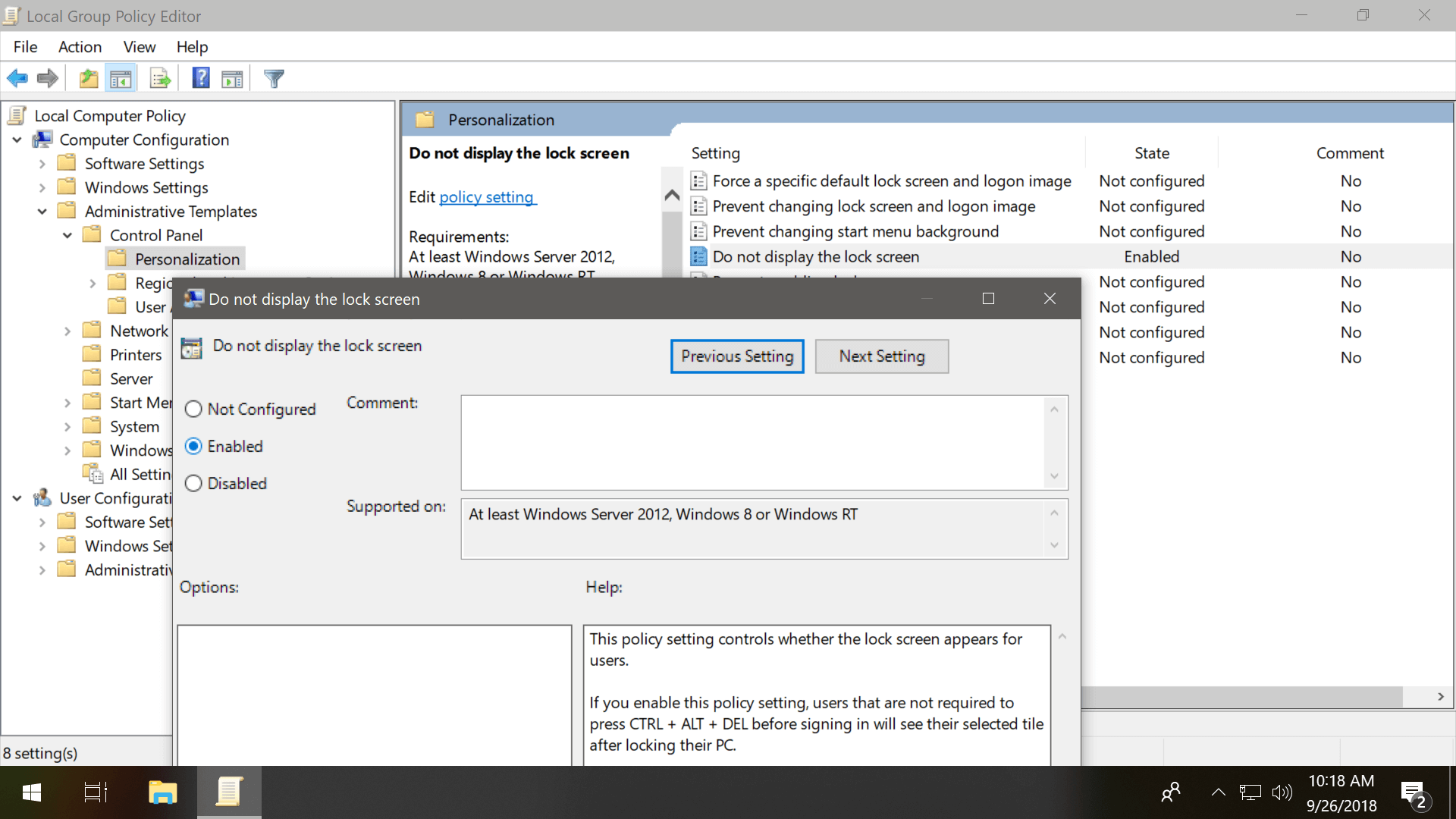
Microsoft's intelligent personal assistant can be annoyingly persistent to get your attention, and will bounce or show notifications and tips from time to time encouraging you to use it. The search box on the Windows taskbar takes up too much space for something that you can just as easily do by pressing the Windows key and start typing.
Microsoft removed the option to switch off Cortana with the Anniversary Update, but if you would prefer your search to stay focused on local files, settings, and apps, you can still curb her enthusiasm by right-clicking anywhere on the taskbar and hovering over "Cortana," which will present options to hide the feature or reduce the search bar to an icon.
Windows 10's assistant can also be shut down through the Windows Registry or the Group Policy Editor, which can be done manually or by simply downloading and double-clicking on these registry shortcut files we've made (all the files for this article are in the same download).
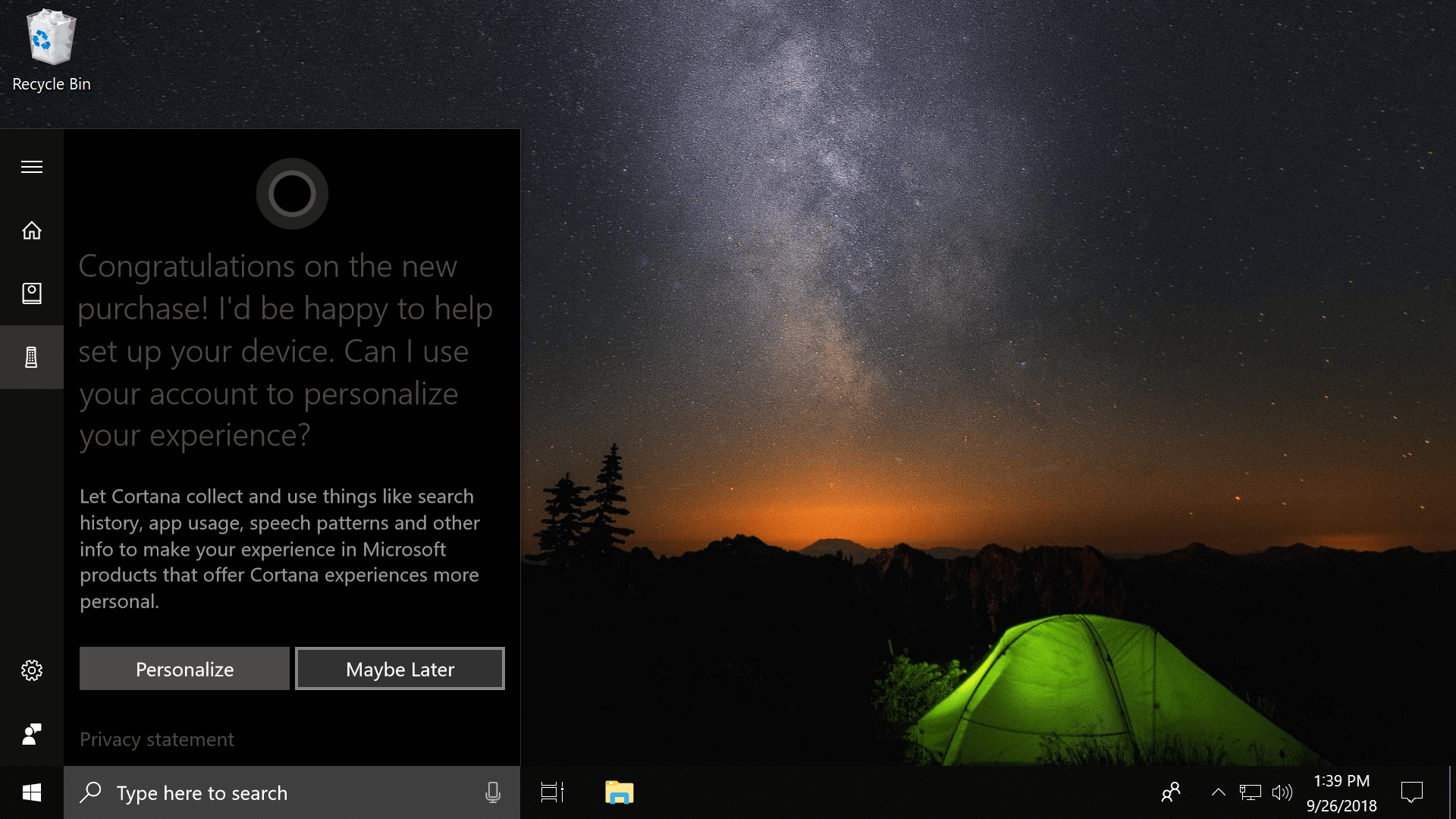
It's great that the Start menu is back in Windows 10 after the Metro interface in Windows 8, but the application launcher still isn't perfect. For instance, while the tiles UI makes it convenient to access your most frequently used applications and programs, it may also serve as prime real estate for advertisers, taking up valuable space in your Start menu.
To prevent annoying ads and suggestions from cropping up in your Start menu, head to Settings > Personalization > Startand set "Show suggestions occasionally in Start" to Off.
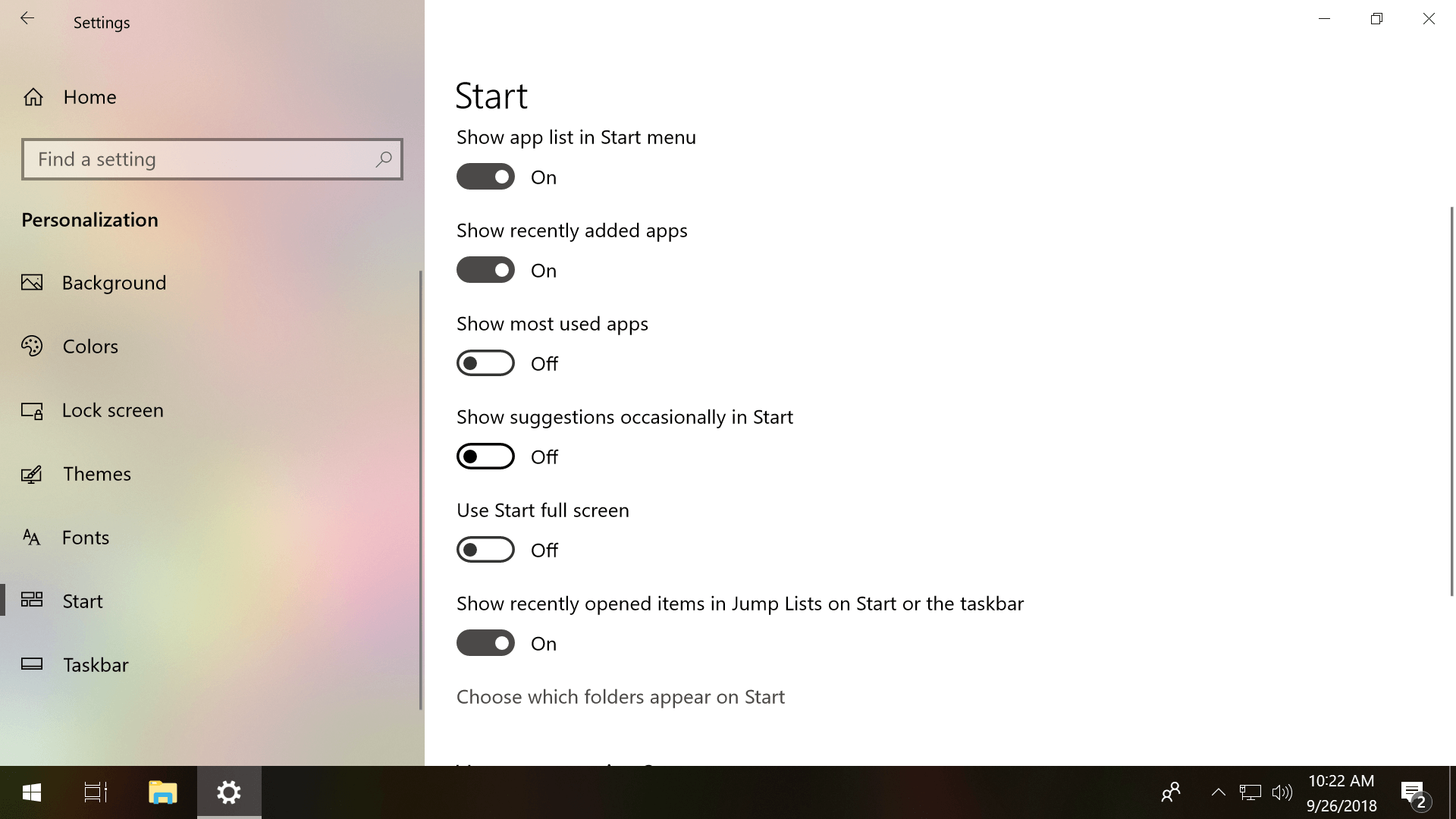
If you are not a fan of Live Tiles (the moving images) you can also disable those by right clicking on a tile and going to More > Turn Live Tile off, or you can select "Unpin from Start" to get rid of the tile entirely. By unpinning all tiles on the right side you can make a single column Start menu and regain some real estate as well.
Those of you who would prefer a Windows 7-style Start menu may also want to check out these third-party tools: Start10 or OpenShell.
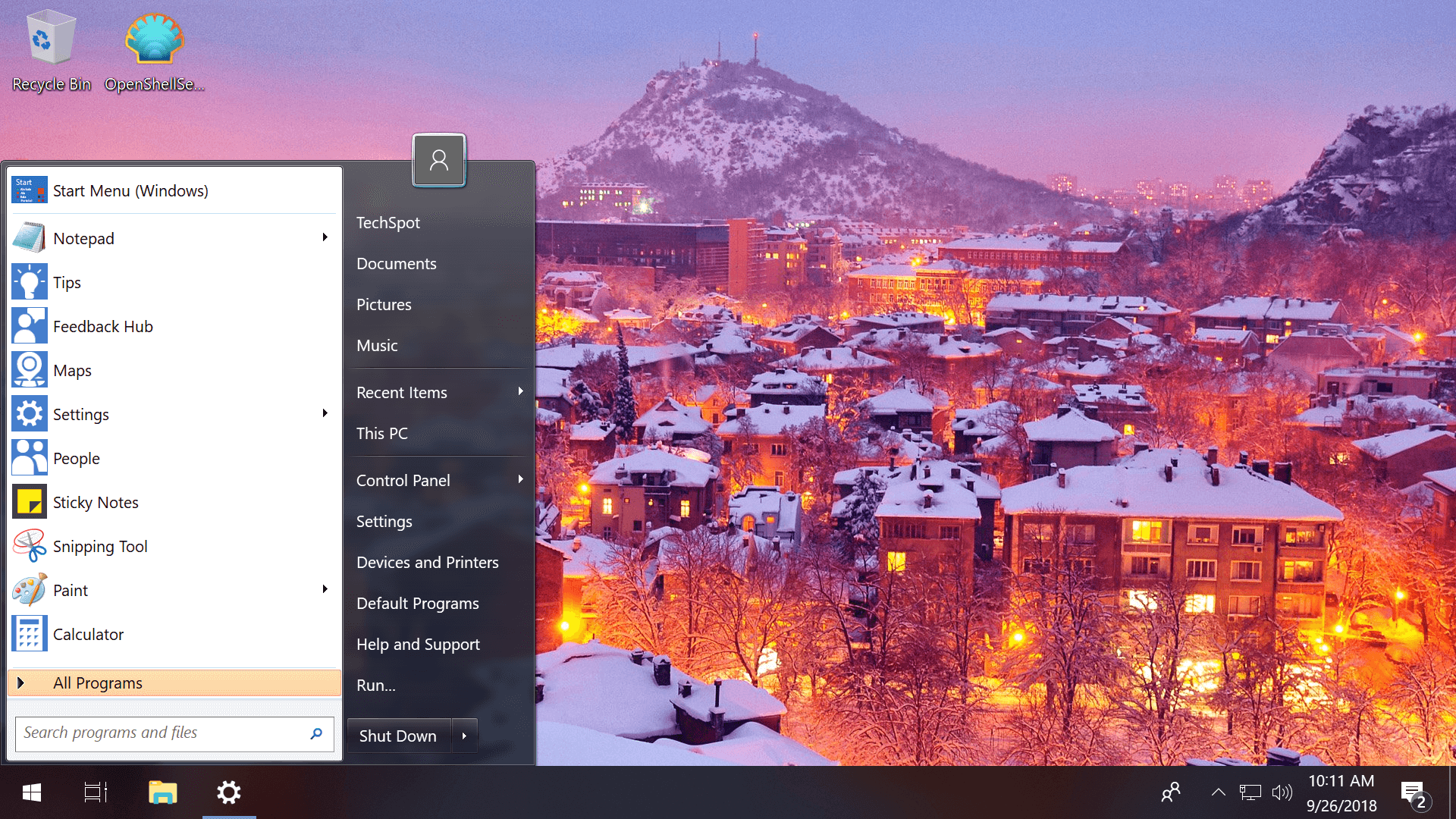
Along with ads elsewhere around it's operating system, Microsoft has begun plugging services such as OneDrive and Office 365 directly in the Windows File Explorer.
These ads can be disabled by opening File Explorer and going to File > Change folder and search options > View, then uncheck the box next to "Show sync provider notifications" and click Apply.
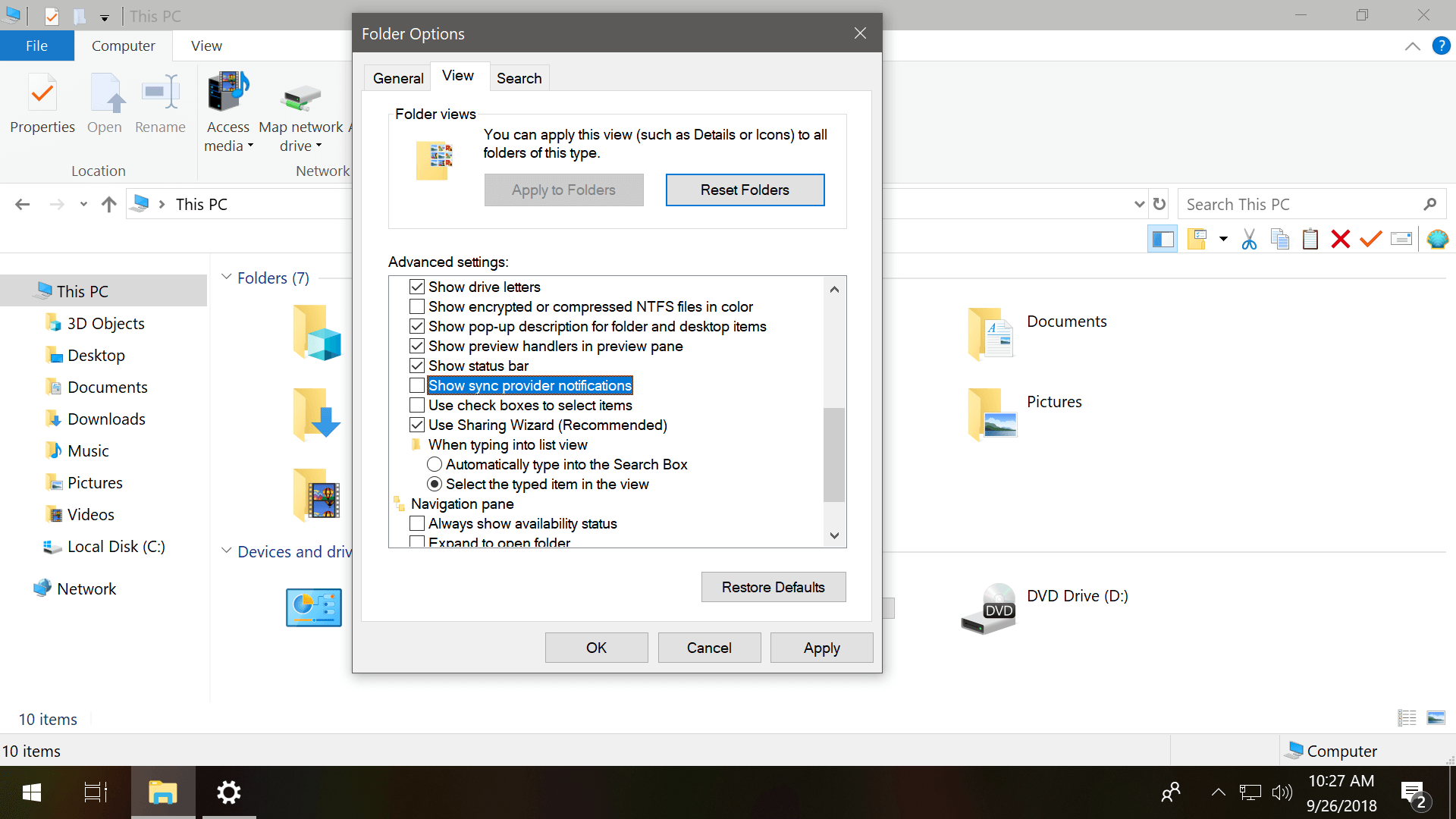
The File Explorer in Windows 10 also displays recommended downloads from the Windows Store when you go to share a file. These recommended apps can be hidden by right clicking on the "Share" window and unchecking "Show app suggestions on the share screen."
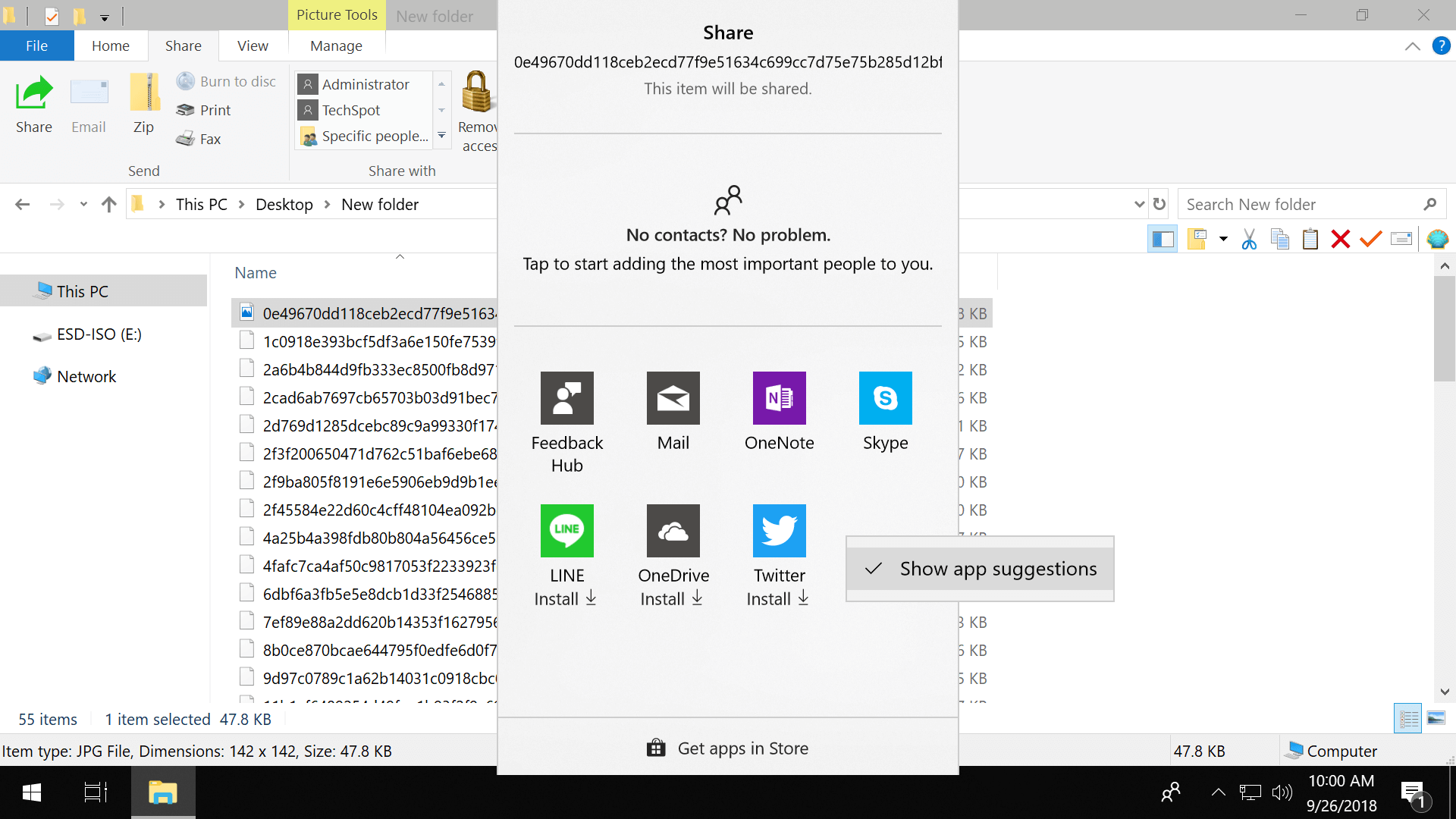
The top right corner of Windows 10's Settings app displays tips and help retrieved from Microsoft's servers. This can be disabled via Group Policy or Registry options as of the Fall Creators Update (version 1709):
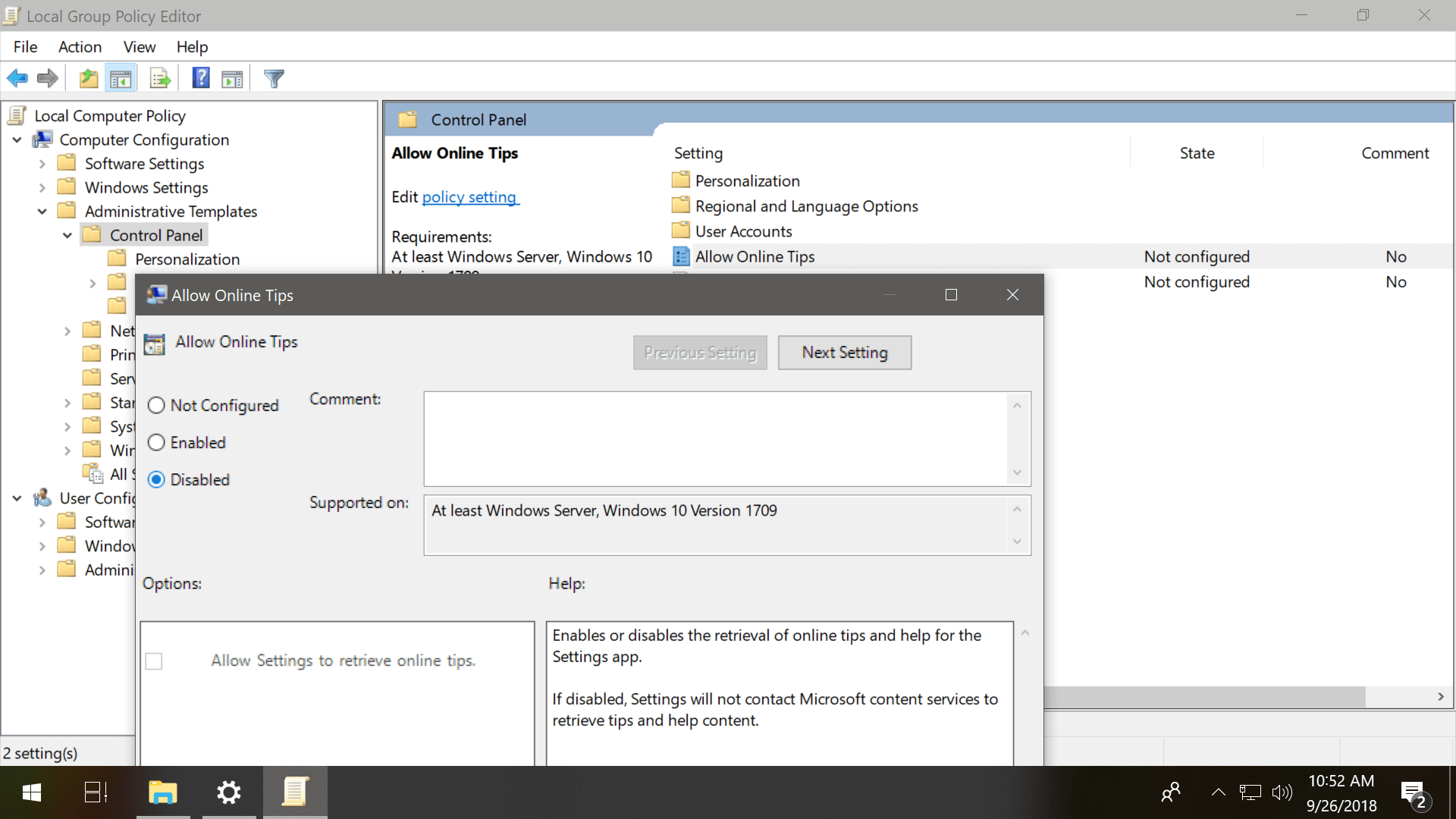
Disable from the Group Policy Editor:
Windows 10 is configured to show notifications that introduce new features in addition to displaying other "tips, tricks, and suggestions" which can include ads such as asking you to try Microsoft's Edge browser instead of the one you're using. Here's how to disable that:
Go to the Settings app > System > Notifications & Action and turn off "Get tips, tricks, and suggestions as you use Windows"
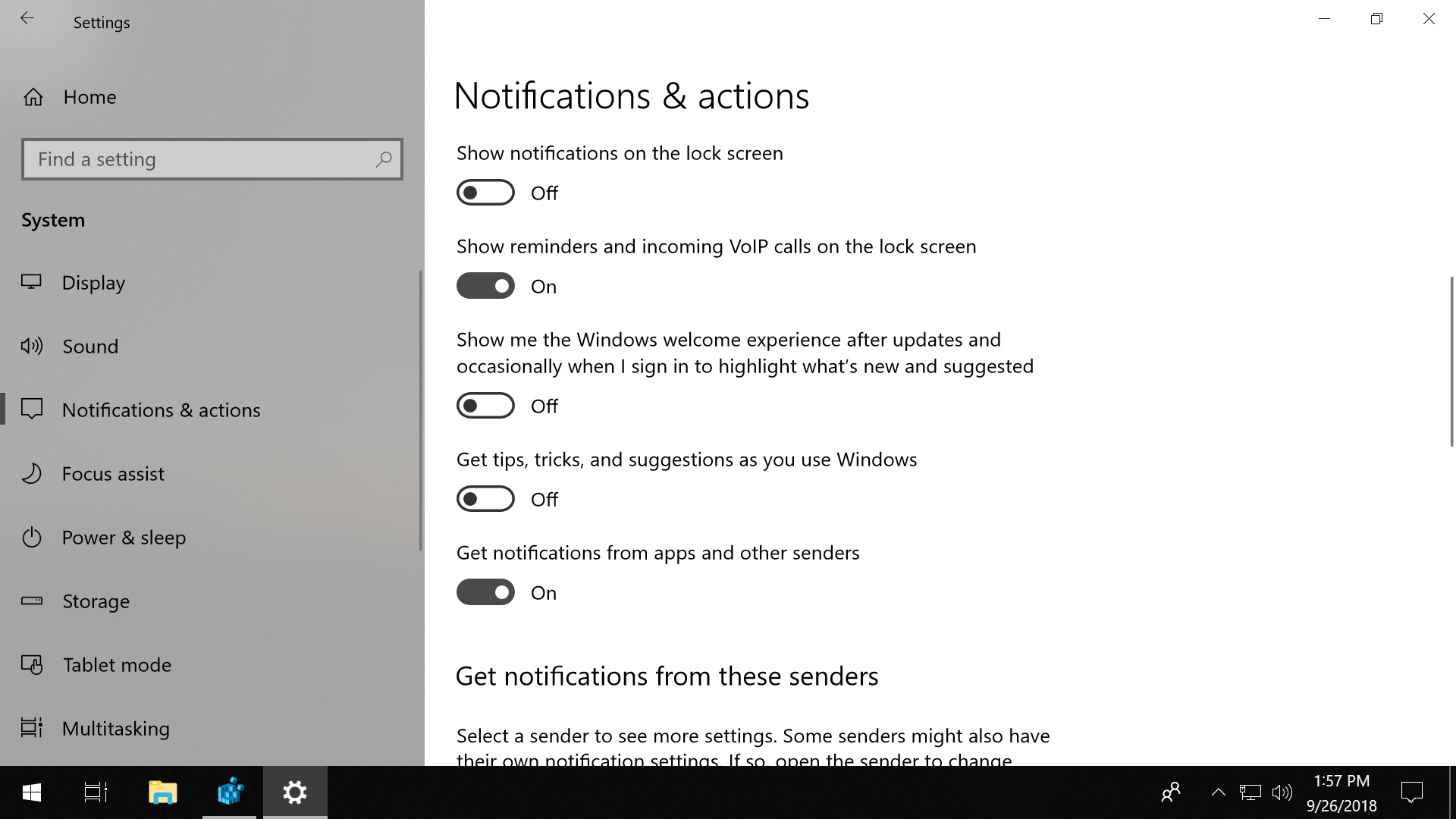
Similar settings you may want to disable:
By default the operating system is configured to sync your account settings to Microsoft's servers when using an online Microsoft account with Windows 10.
The synced data includes your theme profile, passwords, language preferences, as well as ease of access and other Windows settings, which can be disabled individually or entirely by going to the Settings app > Sync settings > Settings > Accounts > Sync and turning items off.
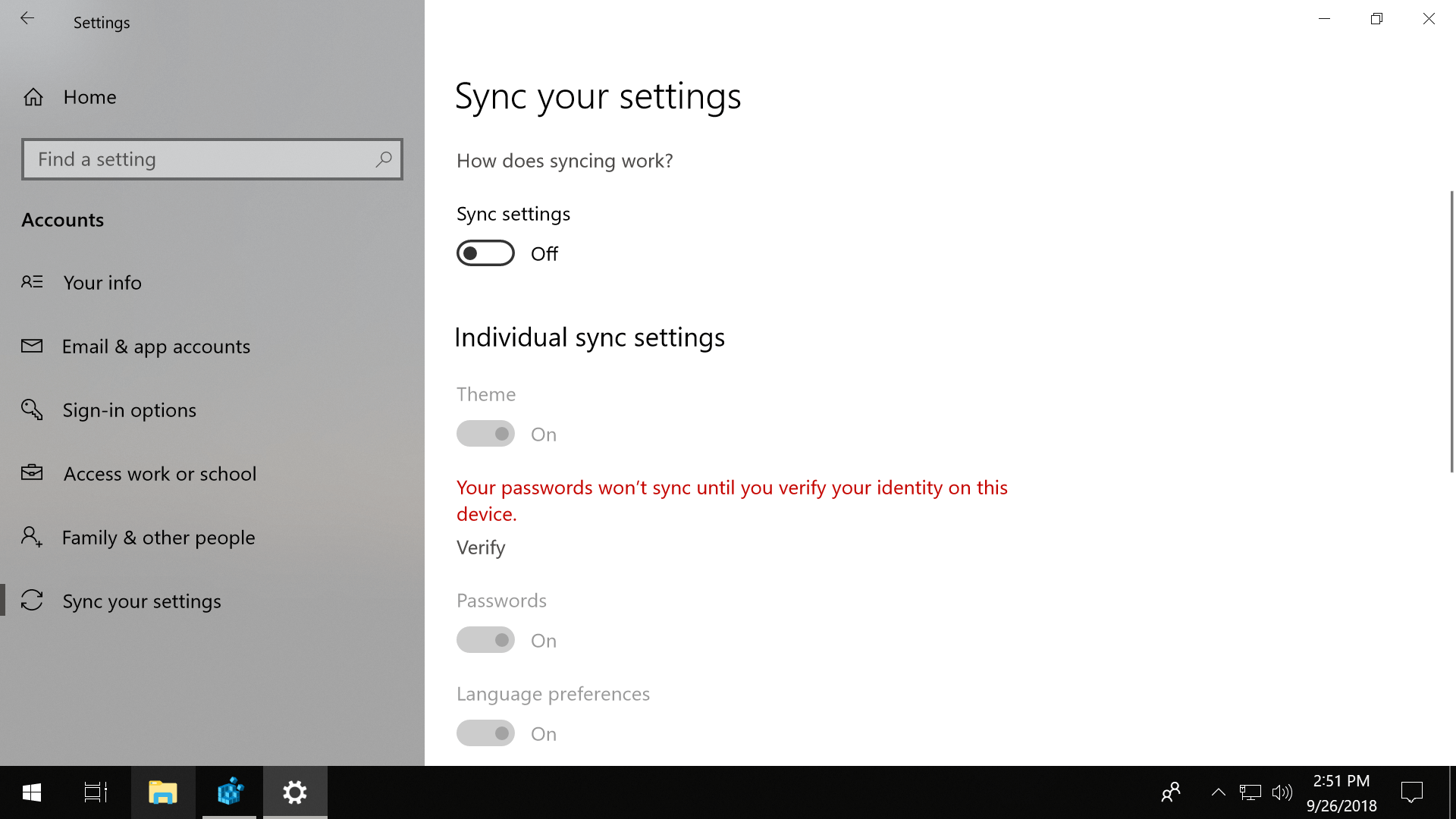
Certain Windows 10 apps can receive information, send notifications and be updated when they're not being used, including the Microsoft Store App and Skype.
Here's where to disable apps from running in the background: Settings app > Privacy > Background apps on the left > Toggle off each app individually. You can also do this via the Windows registry.
There are also other settings that may be of interest in this menu if you scroll through the left column of the Privacy section, including options for Location, Camera, Microphone, Notifications etc.
And here's some software that improves the privacy of Windows 10:Spybot Anti-Beacon | Destroy Windows 10 Spying | O&O ShutUp10
OneDrive is tightly built into Windows 10. It has its own node in File Explorer, and the OneDrive sync client runs automatically at startup, asking you to sign in. Of course, you don't have to use OneDrive if you prefer a cloud service from another provider, like Dropbox or Google Drive, but you can't uninstall it like a normal app.
And while you can change OneDrive settings so that the sync client doesn't run automatically at startup, that still leaves the OneDrive icon in the navigation pane of File Explorer. Fortunately, there are both registry and Group Policy options to completely disable OneDrive (also see this separate guide on removing items from the File Explorer).

Disable from the Windows Registry Editor:
Disable from the Group Policy Editor:
Windows 10 users who don't have Microsoft Office installed are offered to try Office 365, the subscription-based version of the ubiquitous productivity suite, and enjoy a month-long free trial. This is done by a "Get Office" application that sits there for the sole purpose of promoting it.
To stop these notifications head to Settings > System > Notifications & Actionsand switch off notifications for the "Get Office" app.
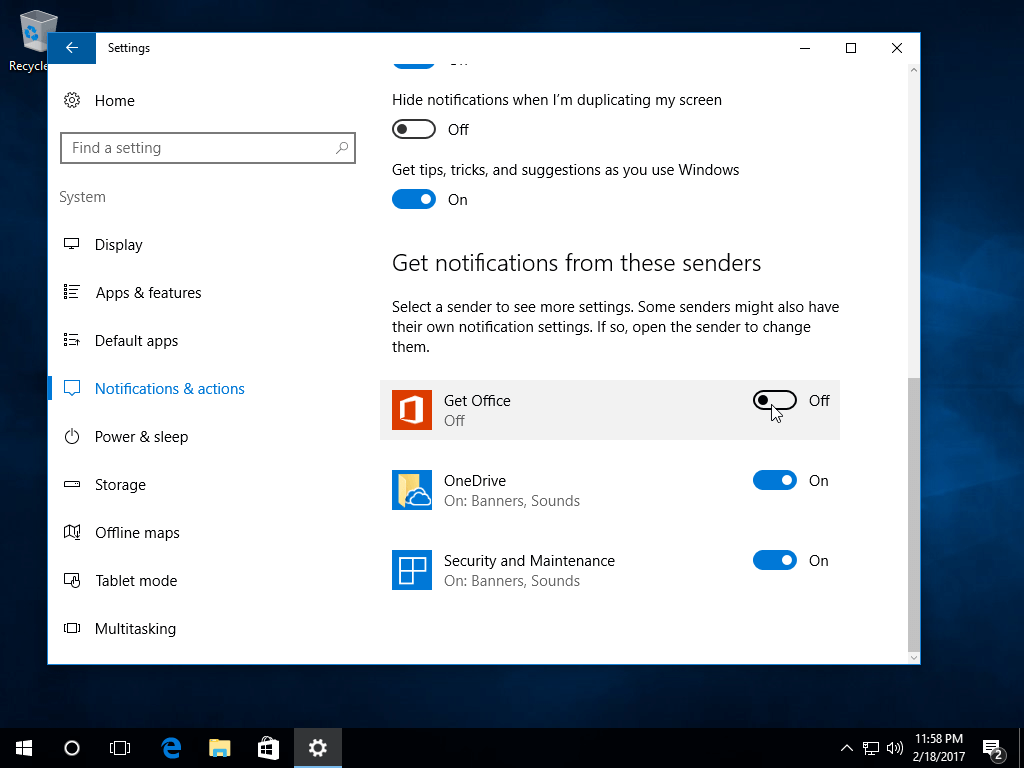
Get-AppxPackage|? name -like MicrosoftOfficeHub|remove-appxpackage
Microsoft notoriously increased the amount of user data that is collected by its operating system with Windows 10. You can limit the amount of information gathered by disallowing telemetry.
From the Group Policy Editor:
From the Registry Editor:
 Best Apple deal: Save $60 on the Apple Watch SE
Best Apple deal: Save $60 on the Apple Watch SE
 Watch your raw memories become mind
Watch your raw memories become mind
 Serena Williams checks John McEnroe on Twitter after his belittling comments
Serena Williams checks John McEnroe on Twitter after his belittling comments
 Prepare to be entranced by these tiny cooking videos
Prepare to be entranced by these tiny cooking videos
 Asus VivoWatch 6 AERO measures blood pressure and ECG
Asus VivoWatch 6 AERO measures blood pressure and ECG
 It was only a matter of time before 'woke' got added to the Oxford English Dictionary
It was only a matter of time before 'woke' got added to the Oxford English Dictionary
 Hey glassholes: Apple just bought an eye
Hey glassholes: Apple just bought an eye
 SNES Classic controller cables will be longer than 3 measly feet
SNES Classic controller cables will be longer than 3 measly feet
 Best Kindle Unlimited deal: Get 3 months of Kindle Unlimited for 99 cents
Best Kindle Unlimited deal: Get 3 months of Kindle Unlimited for 99 cents
 Token smart ring lets you pay instantly with two
Token smart ring lets you pay instantly with two
 NYT Strands hints, answers for April 26
NYT Strands hints, answers for April 26
 Dear Corporate America, leave our LGBTQ Pride celebrations alone
Dear Corporate America, leave our LGBTQ Pride celebrations alone
 Harry Potter 20th anniversary: J.K. Rowling's relationship to fans
Harry Potter 20th anniversary: J.K. Rowling's relationship to fans
 Ice Cube kicks off celebrity 3
Ice Cube kicks off celebrity 3
 Japan orders Google to stop alleged antitrust violations
Japan orders Google to stop alleged antitrust violations
 iOS 11 on the iPad Pro: It’s a whole new world
iOS 11 on the iPad Pro: It’s a whole new world
 Panasonic's deodorizing hanger lets you skip laundry day
Panasonic's deodorizing hanger lets you skip laundry day
 Ethereum price drops 20% after a pile of fake and old news reports
Ethereum price drops 20% after a pile of fake and old news reports
 Someone found an incredibly creative way of sorting Lego bricks using AI
Someone found an incredibly creative way of sorting Lego bricks using AI
The Dyson Airwrap finally has a diffuser attachment'No One Will Save You's twisty ending, explainedOn Tove Jansson’s “Fair Play” and Creative Couples'Saw X' review: A surprisingly sentimental splatterThe Dyson Airwrap finally has a diffuser attachmentCalifornia Street: Learning to Surf in the SixtiesMy Grandmother’s Wheelchair by Stephen HiltnerStaff Picks: Baseball Cards, Barbarian Days, BlowWhat You Learn on Your HoneymoonTwitter/X just fired half of its election integrity teamDon Marquis’s “The Old Soak”#ReadEverywhereMalcolm Lowry Gushes in a Fan Note to Conrad AikenHart Crane’s Bizarre, Audacious Unpublished PoemWhen You Marry Someone Who Has the Same Last NameTwitter/X just fired half of its election integrity teamJohn Ashbery on Movies'No One Will Save You's twisty ending, explainedTinder adds Blind Date featurePoem: George Bradley’s “August in the Apple Orchard” Tesla reportedly puts a stop to free trial of assisted driving service in China · TechNode ByteDance launches Trae AI IDE in China with Doubao Ant Group cuts stake in Orbbec and Youon Technology amid investment shift · TechNode New Alibaba talent program lets top AI recruits choose their own teams · TechNode Chinese milk tea chain Chagee hits $6.2 billion valuation on Nasdaq debut · TechNode Apple set to open sixth Apple Store in Beijing as construction permit is approved · TechNode Embodied intelligence appears in government work report for the first time at NPC · TechNode miHoYo founder’s AI game Whispers From The Star features real Xpeng Motors to invest $413 million in flying cars this year: CEO · TechNode Tencent’s Yuanbao tops Apple’s China App Store, surpassing DeepSeek · TechNode NVIDIA RTX 5060 reportedly launching on May 19, priced at around $349 · TechNode China and EU resume negotiations on EV duties following Trump tariff hikes · TechNode 01.AI founder Kai Microsoft denies shutting down operations in China · TechNode China’s Horizon Robotics offers assisted driving software to Chery · TechNode Kuaishou reports strong 2024 earnings as Kling AI gains traction · TechNode Taobao and Ele.me race into China’s instant retail battlefield · TechNode Tencent upgrades Yuanbao AI with self Chinese ride China Mobile, Huawei, and Leju Robot unveil world's first 5G